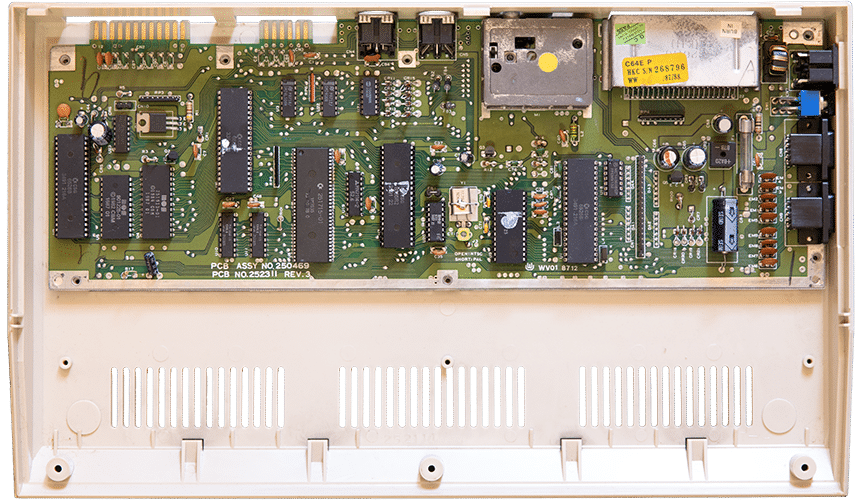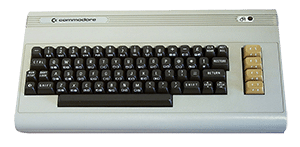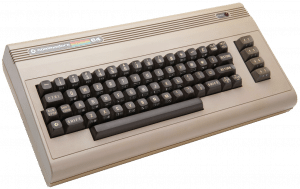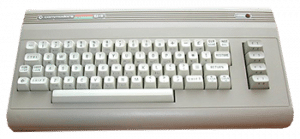

Production: 1982
OS: Kernal / Basic 2.0
The star of the 80s
There is not much to add, you all know the best-selling computer in the world, it is estimated about 17 million units sold.
What made this computer so famous !? definitely the price and its capabilities !. For the time it was really a lot to have 64kb of ram, even if to be honest the non-optimized management made it use almost 39k, it was still possible (for those who program) to disable some functions such as the basic interpreter and kernal to gain additional ram from use for machine language programs.
The features that made it famous are the great expandability with I / O ports, cartridges and the legendary SID (S.ound THEnterface D.evice). At the time, almost all computers and consoles had single-channel audio and often managed directly by the processor. The Commodore 64 used a dedicated chip with 3 independent 8 octave oscillators and 4 waveforms that could make music!
Not to be underestimated the possibility of managing sprites with the video chip that made the games much easier to program and beautiful to look at.
On the other hand we can say that the Basic was not very advanced and it was not easy to manage the graphics as it did not have commands to easily draw on the screen. But what a convenience to turn on the computer and be ready to program and invent something with the Basic.


How many models are there?
1982Silver label
The first versions had the label in silver color with the Commodore logo and next to the LED the writing 64. They are found with the PET computer keyboard and / or with the Orange function keys.

1983Biscottone
The classic and more common Commodore 64 seen around, with gray function keys and rainbow logo. Called in Italy biscottone for its color, while in America breadbin for the shape that resembles a bread box.

1983Portable (C64SX)
After the success of the C64 came out the "portable" version, called C64SX and had a 5 '' color monitor with a 5¼ floppy drive

1986Golden edition
To celebrate the production of 1,000,000 units, a series of 200 gold-colored pieces was created (not sold to the public)

1986Restyiling (C64C)
At this point they decided to "update" the C64 by giving it a line similar to the C128 and above all by reducing the cost of production, which is why in the C64C we find a much smaller motherboard.
1987Sometimes they come back .. (C64 Aldi)
Through a commercial agreement with the Aldi supermarket chain, C64s were produced with the same case from the 1980s but with a white keyboard and sold in these supermarkets, hence the name C64 Aldi.

1989End of series (C64G)
The Commodore 64G sold mainly in Germany and Eastern Europe was white in color and was the last product.
1990Booom (C64GS)
We finish with a bang .. A huge flop, the C64GS (game system) launched in the 90s to face consoles .. How not! using a computer from almost 10 years ago and without a keyboard! so that the many games could not work.

If we talk about peripherals to expand the Commodore we cannot fail to notice all the ports it had.
In addition to the 2 side joystick ports and the connection for the power supply, on the back we can see (starting from left to right of the photo) the expansion port where it is possible to use game cartridges, memory expansions, protectors, diagnostic cartridges and much more. Immediately after there is the selector for the RF frequency and the actual output for the TV. Then the audio / video connector for a composite or s-video output, the serial connector for printers and floppies followed by the cassette port for the recorder and finally the user port with programmable inputs / outputs with the possibility of using a serial transmission .

If you want to relive the magic of this computer you can find an original one on auction sites or flea markets in general, but if you can't find or don't want to spend on a computer complete with power supply, joystick and something to be able to load games into it, you can use an emulator or opt for a new reinterpretation of this computer like The C64, check the link to know what I'm talking about.
New motherboards
The mythical computer is not dead, there are new hardware that are not "emulators", but new cards that mount original chips or new fpga chips.

C64 RELOADED MKII
This new generation card must be completed with a case (new or recovered from an old C64), a keyboard and some original chips.
Required chips:
- N.1 CPU 6510 or 8500
- N.2 CIA 6526 (A) or 8521
- N.1 video chip 6567, 6569, 8565 or 8562
- N.1 or 2 audio chips 6581 and / or 8580

ULTIMATE 64
Totally different, the Ultimate 64 doesn't need any "old" chip to work, just find a case and keyboard to use the new C64
On this tab we find many new features and an hdmi video output! in addition to the possibility of inserting 1 or 2 sid to have the original audio, otherwise the FPGA will be used to generate the sound.
Features:
- N.3 USB ports
- LAN port
- wifi chip
- Battery for rtc
- Ultimate II + card already integrated to emulate 1541 / printers etc.
If you want it is always possible to use a real datassette or a floppy reader or any card for the C64, the only flaw is that to put all these new ports the user port has been "sacrificed", if you need to use it you will also have to buy its cable adapter that from an internal connector on the board will allow you to bring out the classic connector with the I / O ports.
We fix the C64
Nowadays it is easy for the original hardware to have problems but luckily we can find the schematics and get advice via forums or social media.
There are several revisions of cards so you will need to find your own and check the connections, voltages and chips that may be causing the problem.
Below you will find the useful link to find out the causes and download the diagrams, do not rush !.
Peripherals for the C64
There are many peripherals available for the Commodore 64, here I present some useful ones to improve it in addition to the great classics.

Dates 1530

Reader 1541
Faster than the cassette is the C64 floppy drive that matches the biscuit style of the 80s.
LOAD "*", 8 to load the first file or LOAD "$", 8 for the dir.

Ultimate 1541II +
Handyman card that allows you to emulate up to 2 discs (emulated 100%), cassette, player sid, network port, cartridges ...
There is too much to describe, follow this link

MP3-2-C64
You can load cassette games with a computer or phone, using a simple audio cable.

WIFI MODEM
We equip the C64 with WI-FI connectivity. We can connect to the BBS, chat and download files .. Isn't that enough? Well you can also control your home automation!

Tapuino
Digital version with micro SD card to upload .tap files
There are schemes to self-build it with Arduino.

SD2IEC reader
Mini replica from 1541 that reads SD cards.
The emulation is not faithful to the 100%

Skin 32

Dead Test

Super PLA

SID FOR EVERYONE!
Replacement of the original SID.
There are several versions of this famous chip:
(nano) SwinSID, SwinSID ultimate, ArmSID.



